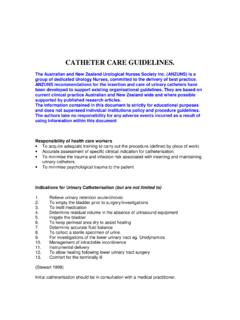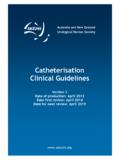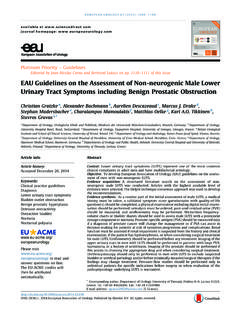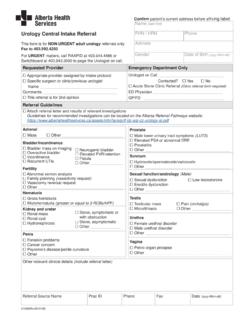Transcription of Catheterisation Clinical Guidelines - anzuns.org
1 Australia and New Zealand Urological Nurses Society Catheterisation Clinical Guidelines Version 2. Date of production: April 2013. Date first review: April 2014. Date for next review: April 2019. Catheterisation Clinical Guidelines Contents Introduction .. 4. Professional Requirements for Nurses .. 6. Indications for Catheterisation .. 7. Urethral .. 7. Suprapubic .. 8. Intermittent .. 8. Term of Catheterisation .. 9. Intermittent Self Catheterisation .. 9. Short Term Catheterisation .. 9. Long Term Catheterisation .. 10. Potential Complications and Contraindications .. 11.
2 Urethral .. 11. Suprapubic .. 11. Intermittent Self Catheterisation .. 12. Catheter Selection and 13. Type .. 14. Materials .. 15. Size .. 17. Length .. 18. Balloon Size .. 19. Drainage Systems .. 20. Bag Selection .. 20. Catheter Valves .. 23. Catheter Securement .. 24. Catheter Storage .. 25. Procedure Guidelines .. 25. Male Urethral Catheterisation .. 25. Female Urethral Catheterisation .. 28. Change of Suprapubic Catheter .. 30. Intermittent Self Catheterisation .. 33. Female Intermittent Self Catheterisation .. 33. Male Intermittent Self Catheterisation .. 35. Neobladder/Stoma Intermittent Self Catheterisation .
3 36. Catheter Management .. 37. Bladder 37. Principles Infection Control (CAUTI) .. 37. Assessing the Need for Catheterisation .. 37. 2. Catheterisation Clinical Guidelines Selection of Appropriate Catheter Type and Drainage System .. 37. Catheter Insertion .. 38. Catheter Maintenance .. 39. 40. Abbreviation List .. 41. References .. 41. Suggested citation Australia and New Zealand Urological Nurses Society Catheterisation Guideline Working Party. Catheterisation Clinical Guidelines . ANZUNS, Victoria (2013). This work is copyright. Apart from any use permitted under the Copyright Act 1968, no part may be reproduced by any process without written permission from Australia and New Zealand Urological Nurses Society.
4 Requests and enquiries concerning reproduction and rights should be addressed to the ANZUNS President via email to 3. Catheterisation Clinical Guidelines Introduction ANZUNS is the peak professional organisation for urology nursing in Australia and New Zealand. ANZUNS objectives are: Education - To create the opportunity for Urology Nurses to undertake research based practice through education Expertise - To provide expertise through the provision of Guidelines , standards of practice and special interest groups Leadership - To provide leadership to facilitate collaboration amongst urology health professionals Australia and New Zealand Urological Nurses Society Inc.
5 (ANZUNS) agreed to develop Clinical Guidelines in this area to contribute to consistency in practice. The Clinical Guidelines for Catheterisation have been in draft format and regularly reviewed since 2001. The Australia and New Zealand Urological Nurses Society Inc. (ANZUNS) project officer has now developed these Guidelines into formal Clinical Practice Guidelines . Trish White, Lynn Brinson and Julia Glentworth have edited this edition, and our thanks also go to the following who kindly volunteered to peer review the document: Audrey Burgin Clinical Project Officer Continence, HACC/MASS Continence Project Queensland, Australia Jean Bothwell Urology Nurse Specialist Waitemata District Health Board, New Zealand Vivienne Dyer Specialty Clinical Nurse Urology Surgical Outpatients, Nelson Marlborough District Health Board, New Zealand Lynda Hardy Clinical Nurse Consultant, Box Hill Hospital Practice Nurse, Australian Urology Associates Pty Ltd, Melbourne, Australia Barbara McPherson Infection Control Advisor Quality and Risk Service, Hawke's Bay District Health Board.
6 New Zealand Kay Talbot Practice Nurse/Manager Australian Urology Associates Pty Ltd, Melbourne, Australia The Guidelines have been produced to assist appropriately trained Health Care Professionals in the safe management of urinary catheters in adults. They can be used as a guide to practice but are not definitive and local policy must be followed. Recommended evidence based best practice has been utilised as a basis for this guideline. 4. Catheterisation Clinical Guidelines Acknowledgment to Wayne Blair, Clinical Photographer, HBDHB, New Zealand, for allowing the use of his photographs.
7 The following are acknowledged for their contribution to developing the initial draft documents and subsequent versions. Draft 1 Trish White and Cheryl Hennah 2001. Draft2 Nicola Walker and Kay Talbot 2003. Draft3 Nicola Walker and Kay Talbot 2004. Draft 4 Kay Talbot and Nicola Walker 2005. Version1 Kay Talbot and AUNS Catheter Care SIG 2006. Version 2 Trish White, Lynn Brinson, Julia Glentworth 2013. Reviewed Michelle Roberts, Clinical Nurse Consultant 2014. 5. Catheterisation Clinical Guidelines Professional Requirements for Nurses Only those Health Care Professionals who are trained and have a clear knowledge and understanding of the urinary tract, the Catheterisation process and the principles of asepsis should be permitted to insert urethral and change suprapubic catheters.
8 A competency based training programme containing the theoretical component of Catheterisation training followed by a period of supervision until the nurse is competent in the technique of Catheterisation is recommended [2, 3].Ongoing refresher courses to review techniques, complications and new products should be available to all staff who catheterise. Community and primary health care workers must be trained in Catheterisation as above[2]. ANZUNS recommends the initial order to insert a catheter must be from a suitably qualified Medical Practitioner, Nurse Practitioner, Advanced Practice Nurse, experienced urological Registered Nurses practicing within their scope of practice and according to local Guidelines .
9 ANZUNS recommends only Nurse Practitioners, Registered Nurses and Enrolled Nurses (who are under delegation and supervision of a Registered Nurse) are permitted to insert urethral and change suprapubic catheters. Advanced Practice Nurses can do initial insertion of a suprapubic catheter if this falls within their scope of practice. An experienced Urology Nurse should do the first suprapubic catheter change. Thereafter a competent Health Care Professional. 6. Catheterisation Clinical Guidelines Indications for Catheterisation Urethral Insertion of a catheter into the urinary bladder via the urethra [4].
10 The indications are: To relieve acute urinary retention or bladder outlet obstruction [5 13]. Close monitoring of urine output in acute renal failure and in the critically ill patient [5 9, 12]. Peri operative use for selected surgical procedures patients undergoing urologic surgery or to other adjoining structures of the genitourinary tract [59]. Anticipated prolonged duration of surgery or patients anticipated to receive large volume infusions or diuretics during surgery [7]. To enable pre and post-operative bladder drainage Trans urethral resection of prostate (TURP)[79,14].
![Index [www.anzuns.org]](/cache/preview/e/5/e/3/7/9/a/a/thumb-e5e379aa8a69f70103ce934b4a1e24f2.jpg)








